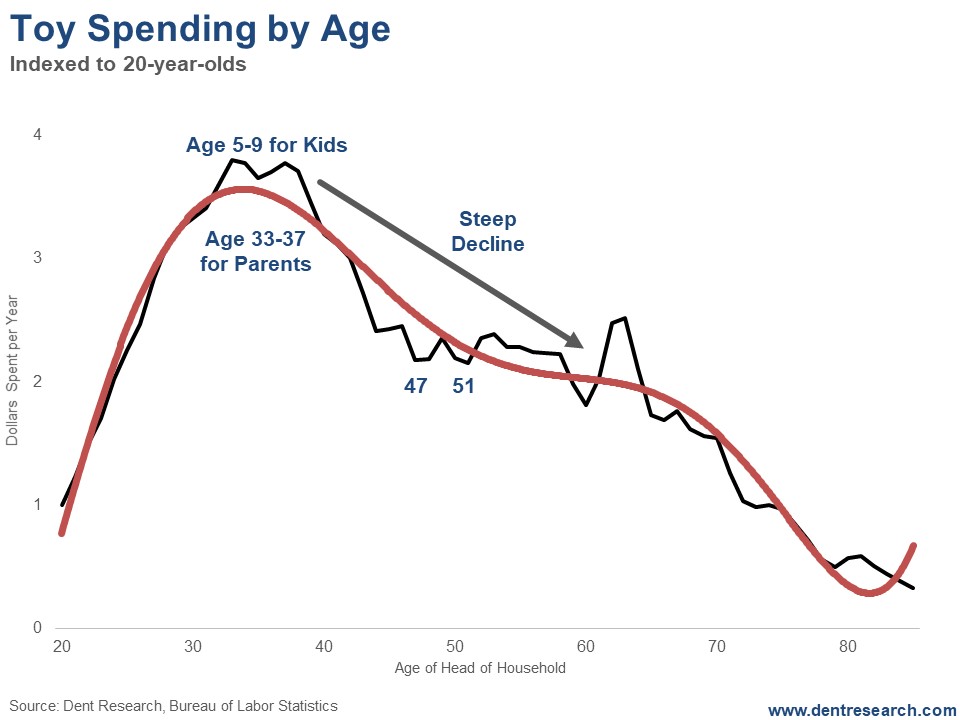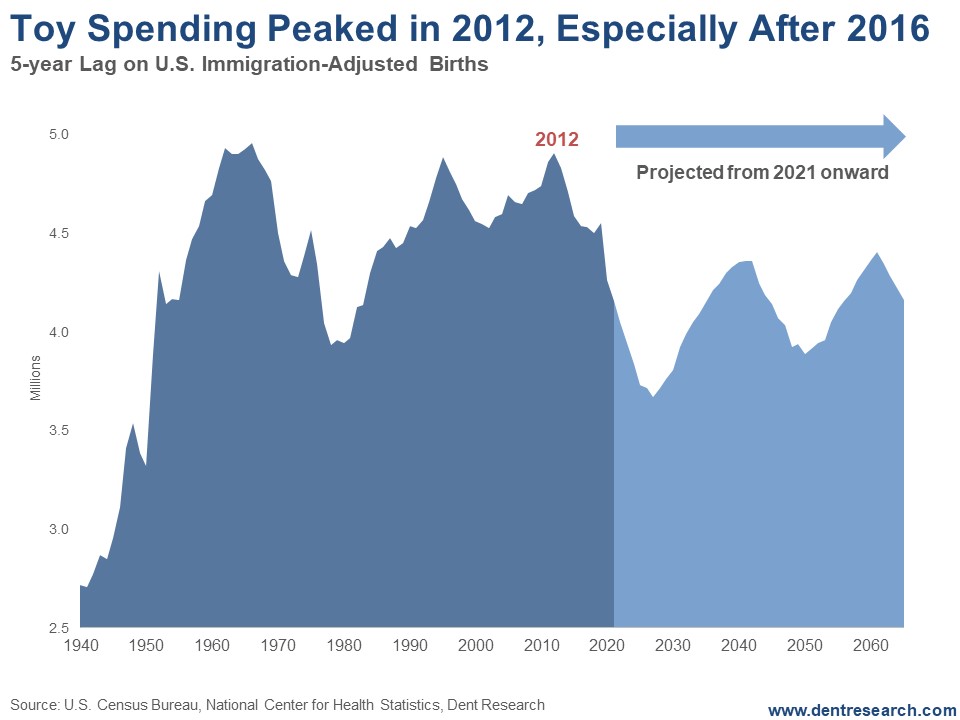Toys R Us just joined the unenviable list of top retail failures of the past decade: Circuit City, Linens-N-Things, A&P (the Great Atlantic & Pacific Tea Company), Sports Authority, and Radio Shack (whose downfall we called in 2016).
While there are many reasons for the loss of these once household names, and Toys R Us is citing massive debt burdens as one element in its undoing, there is a much bigger – and more predictable – underlying factor.
Demographics!
It’s not hard to figure out when toys are most in demand. Age 5 is the peak for kids. There’s a plateau between the ages of 5 and 9. And then a steep drop-off… kids grow up and graduate to alcohol and ecstasy parties instead.
Look at this chart (we have everything from cradle to grave).
And, by the way, for kids, spending on babysitting peaks at the same age as spending on toys: 5 for kids, 33 for their parents.
And calorie intake peaks at age 14 (so spending on potato chips peaks at 42 for parents).
And height peaks at age 19…
And those “minor” bills for college education? They peak when parents are 51 years old on average.
Got any other questions about spending peaks? We’ve got the answers!
But back to toys…
On a 5-year lag, toy spending would have peaked for the Millennial generation in late 2012. With the plateau into age 9, spending would have stayed buoyant into late 2016. After that? Tickets baby!
Toys R Us was a victim of two key trends in our time: debt and demographics.
But probably more important: Toys R Us (and Lego is in trouble as well) is a leading indicator of our entire economy ahead, when endless free money and stimulus hits its nasty hangover.
For Toys R Us, it was a classic leveraged buyout, with $5.3 billion in debt pledged against assets and $7.9 billion in total debt.
Leveraged up to its eyeballs…
And by my old employer, Bain & Company (Bain Capital). If only they’d consulted me before entering a collapsing demographic sector.
Retailers are also leading defaults at three times average for American companies in a shrinking environment… due to slowing demographic trends (more from the aging Baby Boomers) and competition from the almighty Amazon and online retailers… “Heil Bezos!”
Debts will quickly be written off, but demographic trends will continue down into at least 2028.
This is literally a dying industry, but from younger kids, not older Boomers. We’re likely never to see higher birth rates than 2007 again, as I’ve been warning for decades now.
If you’re in the nursing home/assisted living sector, brace for incredible growth in the years ahead, as Baby Boomers age into 2045-plus.
If you’re in a child-focused business, convert childcare centers into assisted living centers. And if you are in the diaper business, focus on adult diapers, not baby diapers.
Demographics will always steer you in the right direction for investment and business.
The content of our articles is based on what we’ve learned as financial journalists. We do not offer personalized investment advice: you should not base investment decisions solely on what you read here. It’s your money and your responsibility. Our track record is based on hypothetical results and may not reflect the same results as actual trades. Likewise, past performance is no guarantee of future returns. Certain investments such as futures, options, and currency trading carry large potential rewards but also large potential risk. Don’t trade in these markets with money you can’t afford to lose. Delray Publishing LLC expressly forbids its writers from having a financial interest in their own securities or commodities recommendations to readers.
Recommended Content
Editors’ Picks
EUR/USD retreats below 1.0700 after US GDP data

EUR/USD came under modest bearish pressure and retreated below 1.0700. Although the US data showed that the economy grew at a softer pace than expected in Q1, strong inflation-related details provided a boost to the USD.
GBP/USD declines below 1.2500 as USD rebounds

GBP/USD declined below 1.2500 and erased the majority of its daily gains with the immediate reaction to the US GDP report. The US economy expanded at a softer pace than expected in Q1 but the price deflator jumped to 3.4% from 1.8%.
Gold drops below $2,320 as US yields shoot higher

Gold lost its traction and turned negative on the day below $2,320 in the American session on Thursday. The benchmark 10-year US Treasury bond yield is up more than 1% on the day above 4.7% after US GDP report, weighing on XAU/USD.
XRP extends its decline, crypto experts comment on Ripple stablecoin and benefits for XRP Ledger

Ripple extends decline to $0.52 on Thursday, wipes out weekly gains. Crypto expert asks Ripple CTO how the stablecoin will benefit the XRP Ledger and native token XRP.
After the US close, it’s the Tokyo CPI

After the US close, it’s the Tokyo CPI, a reliable indicator of the national number and then the BoJ policy announcement. Tokyo CPI ex food and energy in Japan was a rise to 2.90% in March from 2.50%.

